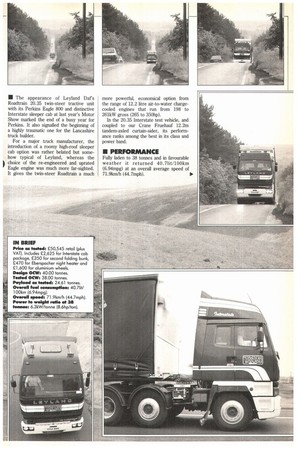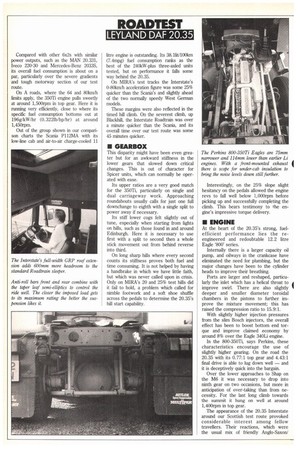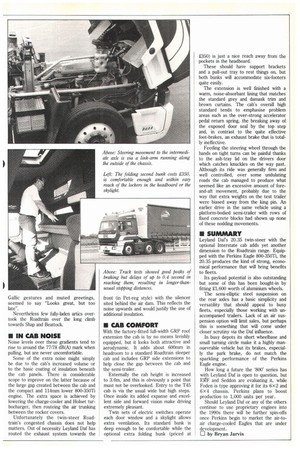AGLE FLIES FOR LEYLAND
Page 62

Page 63

Page 64

Page 65

If you've noticed an error in this article please click here to report it so we can fix it.
• The appearance of Leyland Dais Roadtrain 20.35 twin-steer tractive unit with its Perkins Eagle 800 and distinctive Interstate sleeper cab at last year's Motor Show marked the end of a busy year for Perkins. It also signalled the beginning of a highly traumatic one for the Lancashire truck builder.
For a major truck manufacturer, the introduction of a roomy high-roof sleeper cab option was rather belated but somehow typical of Leyland, whereas the choice of the re-engineered and uprated Eagle engine was much more far-sighted. It gives the twin-steer Roadtrain a much more powerful, economical option from the range of 12.2 litre air-to-water chargecooled engines that run from 198 to 261kW gross (265 to 350hp).
In the 20.35 Interstate test vehicle, and coupled to our Crane Fruehauf 12.2m tandem-axled curtain-sider, its performance ranks among the best in its class and power band.
• PERFORMANCE
Fully laden to 38 tonnes and in favourable weather it returned 40.71it/100km (6.94mpg) at an overall average speed of 71.9km/h (44.7mph). Compared with other 6x2s with similar power outputs, such as the MAN 20.331, Iveco 220.30 and Mercedes-Benz 20335, its overall fuel consumption is about on a par, particularly over the severe gradients and tough motorway section of our test route.
On A roads, where the 64 and 801an/h limits apply, the 350Ti engine pulls sweetly at around 1,500rpm in top gear. Here it is running very efficiently, close to where its specific fuel consumption bottoms out at 196g/kW/hr (0.3221b/hp/hr) at around 1,4501pm.
Out of the group shown in our comparison charts the Scania P112MA with its low-line cab and air-to-air charge-cooled 11 litre engine is outstanding. Its 38,1lit/1001crn (7.4mpg) fuel consumption ranks as the best of the 240kW-plus three-axled units tested, but on performance it falls some way behind the 20.35.
On MIRA's test tracks the Interstate's 0-80Ion/h acceleration figure was some 25% quicker than the Scania's and slightly ahead of the two normally speedy West Getman models.
These margins were also reflected in the timed hill climb. On the severest climb, up Blackhill, the Interstate Roadtrain was over a minute quicker than the Scania, and its overall time over our test route was some 45 minutes quicker.
• GEARBOX
This disparity might have been even greater but for an awkward stiffness in the lower gears that slowed down critical changes. This is out of character for Spicer units, which can normally be operated with ease.
Its upper ratios are a very good match for the 35011, particularly on single and dual carriageway work. Approaching roundabouts usually calls for just one full downchange to eighth with a single split to power away if necessary.
Its stiff lower cogs felt slightly out of tune, especially when starting from lights on hills, such as those found in and around Edinburgh. Here it is necessary to use first with a split to second then a whole stick movement out from behind reverse into third.
On long sharp hills where every second counts its stiffness proves both fuel and time consuming. It is not helped by having a handbrake in which we have little faith, but which was never called upon in crisis. Only on MIRA's 20 and 25% test hills did it fail to hold, a problem which called for nimble footwork and a soft shoe shuffle across the pedals to determine the 20.35's hill start capability. Interestingly, on the 25% slope slight hesitancy on the pedals allowed the engine revs to fall well below 1,000rpm before picking up and successfully completing the climb. This bears testimony to the engine's impressive torque delivery.
• ENGINE
At the heart of the 20,35's strong, fuelefficient performance lies the reengineered and redoubtable 12.2 litre Eagle '800' series.
Internally there is a larger capacity oil pump, and oilways in the crankcase have eliminated the need for plumbing, but the major changes have been to the cylinder heads to improve their breathing.
Ports are larger and reshaped, particularly the inlet which has a helical throat to improve swirl. There are also slightly deeper and smaller diameter toroidal chambers in the pistons to further improve the mixture movement; this has raised the compression ratio to 15.9:1.
With slightly higher injection pressures from the slim Bosch injectors, the overall effect has been to boost bottom end torque and improve claimed economy by around 8% over the Eagle 340LA engine.
In the 800-350Ti, says Perkins, these characteristics encourage the use of slightly higher gearing. On the road the 20.35 with its 0.77:1 top gear and 4.43:1 final drive is able to lug down well — and it is deceptively quick into the bargain.
Over the lower approaches to Shap on the M6 it was necessary to drop into ninth gear on two occasions, but more in anticipation of over-taking than from necessity. For the last long climb towards the summit it hung on well at around 1,400rpm in top gear.
The appearance of the 20.35 Interstate around our Scottish test route provoked considerable interest among fellow travellers. Their reactions, which were the usual mix of friendly Anglo-Saxon/ Gallic gestures and muted greetings, seemed to say "Looks great, but too late".
Nevertheless few fully-laden artics overtook the Roadtrain over the long climb towards Shap and Beattock.
• IN CAB NOISE
Noise levels over these gradients tend to• rise to around the 77/78 dB(A) mark when pulling, but are never uncomfortable.
Some of the extra noise might simply be due to the cab's increased volume or to the basic coating of insulation beneath the cab panels. There is considerable scope to improve on the latter because of the large gap created between the cab and the compact and 114nun lower 800-350Ti engine. The extra space is achieved by lowering the charge-cooler and flolset turbocharger, then routeing the air trunking between the rocker covers.
Unfortunately the twin-steer Roadtrain's congested chassis does not help matters. Out of necessity Leyland Daf has routed the exhaust system towards the front (in Pet-reg style) with the silencer sited behind the air dam. This reflects the noise upwards and would justify the use of additional insulation.
• CAB COMFORT
With the factory-fitted full-width GRP roof extension the cab is by no means lavishly equipped, but it looks both attractive and aerodynamic. It adds about 600mm in headroom to a standard Roadtrain sleeper cab and includes GRP side extensions to help close the gap between the cab and the semi-trailer.
Externally the cab height is increased to 3.6m, and this is obviously a point that must not be overlooked. Entry to the T45 cab is via the usual wide but high steps. Once inside its added expanse and excellent side and forward vision make driving extremely pleasant.
Twin sets of electric switches operate each door window and a skylight allows extra ventilation. Its standard bunk is deep enough to be comfortable while the optional extra folding bunk (priced at P..350) is just a nice reach away from the pockets in the headboard.
These should have support brackets and a pull-out tray to rest things on, but both bunks will accommodate six-footers quite easily.
The extension is well finished with a warm, noise-absorbant lining that matches the standard grey and damask trim and brown curtains. The cab's overall high standard tends to emphasise problem areas such as the over-strong accelerator pedal return spring, the breaking away of the exposed door seal by the top step and, in contrast to the quite effective foot-brakes, an exhaust brake that is totally ineffective.
Feeding the steering wheel through the hands on tight turns can be painful thanks to the ash-tray lid on the drivers door which catches knuckles on the way past. Although its ride was generally firm and well controlled, over some undulating roads the cab managed to produce what seemed like an excessive amount of foreand-aft movement, probably due to the way that extra weights on the test trailer were biased away from the king pin. An earher drive in the same vehicle using a platform-bodied semi-trailer with rows of fixed concrete blocks had shown up none of these nodding movements.
• SUMMARY
Leyland Dal's 20.35 twin-steer with the optional Interstate cab adds yet another dimension to the Roadtrain range. Equipped with the Perkins Eagle 800-350Ti, the 20.35 produces the kind of strong, economical performance that will bring benefits to fleets.
Its payload potential is also outstanding but some of this has been bought-in by fitting £1,600 worth of aluminium wheels.
The semi-elliptic steel suspension on the rear axles has a basic simplicity and versatility that should appeal to busy fleets, especially those working with unaccompanied trailers. Lack of an air suspension option will limit sales, but perhaps this is something that will come under closer scrutiny via the Daf influence.
In busy depots its short wheelbase and small turning circle make it a highly manouevrable vehicle but its brakes, especially the park brake, do not match the sparkling performance of the Perkins Eagle engine.
How long a future the '800' series has with Leyland Daf is open to question, but ElIF and Seddon are evaluating it, while Paden is type approving it for its 6x2 and 6 x 4 chassis. Perkins plans to boost production to 1,000 units per year.
Should Leyland Daf or any of the others continue to use proprietary engines into the 1990s there will be further spin-offs once Perkins begin to market the air-toair charge-cooled Eagles that are under development.
Li by Bryan Jarvis










































































































